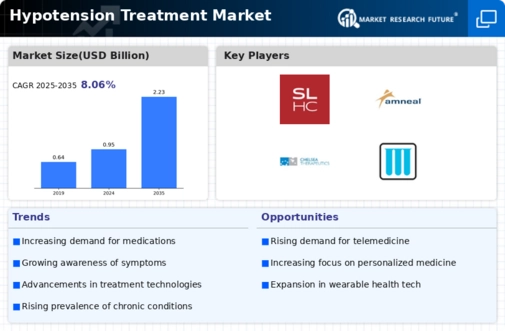Hypotension Treatment Size
Hypotension Treatment Market Growth Projections and Opportunities
The hypotension treatment market is influenced by a host of different factors that shape its dynamics and growth trajectory. One of the main drivers is the increasing prevalence of hypotension across the globe, as people age worldwide and sedentary lifestyles become more common giving rise to Low Blood Pressure Incidence. This shift in demographics creates a large patient population requiring effective treatment options leading to increased demand for hypotension drugs and therapies.
Medical research and technology advancement also make significant contributions towards the market’s expansion. The ongoing efforts to understand the background causes of hypotension along with innovative approaches to its treatment improve safety and efficacy profiles of existing therapies. Such trends create proper competition between pharmaceutical companies who want to enter this area with new medications therefore making wider range possible for healthcare providers.
Regulations also define how the hypotension treatment market looks like. Strict regulatory frameworks surround approval and commercialization of new medications as well as therapies. By doing so, patients’ health is protected while product effectiveness becomes guaranteed but this comes with implications on market players. Companies are required to go through complex regulatory processes, carry out extensive clinical trials, followed by strict set standards before introducing their products into markets. Therefore, it makes it difficult for an entrant coming into industry such this one because they have first been set by these regulations in place about.
Healthcare infrastructure and access to medical facilities are critical factors affecting the hypotension treatment market. In areas where healthcare infrastructure is strong there is greater access diagnostic tools and treatments options available . Conversely, diagnosis and treatment may be affected in parts where healthcare resources are limited . Hence, variations in geographical accessibility drive differences in regional market demand.
Economic factors also exert a significant impact on the hypotension treatment market. Affordability concerns together with reimbursement policies may hinder patients from seeking required help when that time come s . In times of economic downturns , less spending occurs within health care sector thereby slowing down penetration of hypotension treatments . However, a strong economy and an increase in disposable income can lead to higher health care spending thereby increasing the demand for advanced and expensive treatment options .
Another determinant of market dynamics is the medical industry’s cooperation and partnership. Pharmaceutical companies often engage in strategic alliances with research institutions, academic organizations, and other industry players to leverage collective expertise and resources. These types of arrangements speed up introduction of new therapies, promote innovation as well as make hypotension treatment market more competitive.
Consumer awareness and education also play a vital role in market growth. The knowledge about hypotension symptoms and their treatment options makes many persons visit health care providers seeking diagnosis or advice. This increased consumer information not only stimulates current market demand but also entails the development of new products that address changing needs from educated patients.”









Leave a Comment